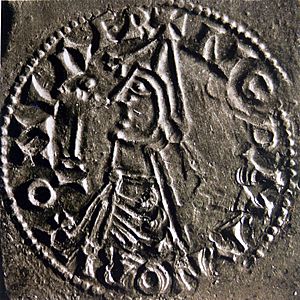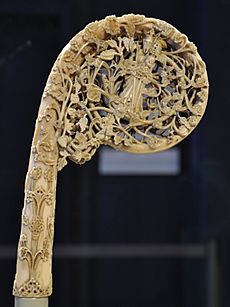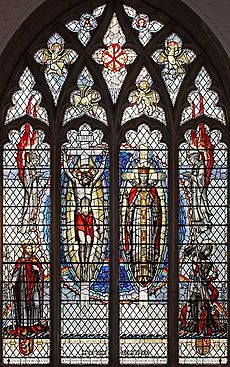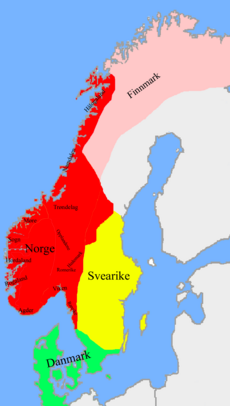Olaf II of Norway facts for kids
Quick facts for kids Olaf II Haraldsson |
|||||
|---|---|---|---|---|---|

Coin of Olaf dated 1023–28
|
|||||
| King of Norway | |||||
| Reign | 1015–1028 | ||||
| Predecessor | Sweyn Forkbeard | ||||
| Successor | Cnut the Great | ||||
| Born | c. 995 Ringerike, Norway |
||||
| Died | 1030 Battle of Stiklestad Stiklestad, Norway |
||||
| Spouse | Astrid Olofsdotter of Sweden | ||||
| Issue | Wulfhild, Duchess of Saxony Magnus, King of Norway (illegitimate) |
||||
|
|||||
| House | St. Olaf | ||||
| Father | Harald Grenske | ||||
| Mother | Åsta Gudbrandsdatter | ||||
| Religion | Roman Catholicism | ||||
Olaf II Haraldsson (born around 995 – died July 29, 1030) was the King of Norway from 1015 to 1028. After his death, he became known as Saint Olaf. He was given the special title Rex Perpetuus Norvegiae, which means "Eternal King of Norway".
Olaf was made a saint by Bishop Grimkell in Nidaros (today called Trondheim) just one year after he died in the Battle of Stiklestad. His body was placed in Nidaros Cathedral. His sainthood helped many Scandinavian Vikings and Norsemen become Christians.
In 1164, Pope Alexander III officially recognized Olaf as a saint of the Catholic Church. This made him known as the "eternal king of Norway" across Europe. Even after the Reformation, many Lutherans and Anglicans still remember him as an important historical figure.
Olaf's story became a big part of Norway's national identity. He was a symbol of Norwegian independence and pride. Saint Olaf is shown with an axe in Norway's coat of arms. His celebration day, Olsok, is still held on July 29. Many Christian groups and Norway's Order of St. Olav are named after him.
Contents
Who Was King Olaf II?
Olaf's Old Norse name was Óláfr Haraldsson. People also called him Olaf "the fat" or "the stout" because he was strong. Some even called him Olaf "the Lawbreaker" because he was very strict in converting people to Christianity. Today in Norway, he is called Olav den hellige (Olaf the Holy) or Heilag-Olav (the Holy Olaf).
His name, Óláfr, means "forefather's heir". In modern Norwegian, it's Olav. Other countries have their own versions, like Ólafur in Iceland and Olof in Sweden. In England, he was traditionally called Olave. He is sometimes called Rex Perpetuus Norvegiae, meaning "Norway's Eternal King".
Olaf's Early Life and Family
Olaf II was born in Ringerike, Norway. His mother was Åsta Gudbrandsdatter, and his father was Harald Grenske. Harald was a "petty king," which means he ruled a small area in Vestfold. Harald died before Olaf was born.
Olaf's mother, Åsta, later married Sigurd Syr. They had more children, including Harald Hardrada, who also became a king of Norway. Olaf's family had some connections to earlier kings who had tried to unite Norway.
Historians learn about Olaf from old texts. The oldest is a poem called Glælognskviða, which talks about Olaf and some miracles. Many sagas (long stories) from Iceland also tell his story. One famous saga is Heimskringla by Snorri Sturluson, which is like a history book of the Norwegian kings.
Olaf's Reign as King
As a teenager, Olaf traveled a lot. He went to the Baltic Sea area, then to Denmark and England. Some old poems say he helped take down London Bridge in 1014. This might have helped King Æthelred get his throne back from the Danes.
Olaf wanted to unite Norway into one kingdom, just like Harald Fairhair had done before him. On his way home, he stayed with Duke Richard II in Normandy. This area had been settled by Norsemen. Richard was a strong Christian, and the Normans had already become Christian. Before leaving, Olaf was baptized in Rouen Cathedral by Richard's brother.
Olaf returned to Norway in 1015 and declared himself king. He got support from five "petty kings" in the Norwegian Uplands. In 1016, he defeated Earl Sweyn at the Battle of Nesjar. Earl Sweyn had been the real ruler of Norway. Olaf also founded the town of Borg, now called Sarpsborg. In just a few years, Olaf gained more power than any king before him.
He made peace with King Olof Skötkonung of Sweden. Olaf was supposed to marry Olof's daughter, Ingegerd, but Olof didn't approve. So, in 1019, Olaf married Astrid Olofsdotter, Olof's other daughter. They had a daughter named Wulfhild.
However, Olaf's success didn't last long. In 1026, he lost the Battle of the Helgeå. In 1029, many Norwegian nobles were unhappy with Olaf. They supported King Cnut the Great of Denmark, who invaded Norway. Olaf was forced to leave Norway and went to Kievan Rus.
When King Cnut's ruler in Norway disappeared at sea, Olaf saw a chance to get his kingdom back. He got help from the Swedish king and tried to return to Norway. But in 1030, Olaf was killed in the Battle of Stiklestad. Some of his own people from central and northern Norway fought against him.
After Olaf's death, King Cnut ruled Norway for five years. But Cnut's son and his mother, who were ruling Norway, became very unpopular. So, Olaf's son, Magnus the Good, claimed the throne, and Cnut's family had to flee.
Spreading Christianity in Norway

Olaf is often seen as the person who brought Christianity to Norway. However, many historians now think that Christianity was already spreading in Norway before Olaf's time. Olaf did bring Bishop Grimkell with him, who helped organize the church in Norway. Olaf likely tried to bring Christianity to the inland areas of Norway, where it was less common.
Some historians also point out that Olaf could be violent and brutal. Like many kings of his time, he might have used Christianity to gain more power for himself and to control Norway better. The old poems about Olaf don't talk much about Christianity. Instead, they use references from Norse paganism.
Historians believe that converting to Christianity was a long process for Scandinavians. They adopted Christian practices over time. Olaf is shown as a saintly figure in later stories, but the real Olaf might have been different.
How Olaf Became a Saint
Olaf quickly became Norway's patron saint. Bishop Grimkell officially made him a saint just one year after his death. The worship of Olaf helped unite the country and made Christianity stronger in Norway. He is also the patron saint of the Faroe Islands.
It's hard to know exactly what the historical Olaf was like because so many myths grew around him. Based on what we know, he wasn't always a successful ruler. His power came from an alliance with the stronger King Cnut. He was exiled and his attempt to win back his kingdom failed quickly.
So, why did he become so important after his death?
- The myth of his role in Christianizing Norway: People believed he was the main force behind Norway becoming Christian.
- Family connections: After King Cnut died, Olaf's son, Magnus the Good, became king of Norway and later Denmark. Magnus worked hard to promote his father's sainthood.
- Need for legitimacy: In later times, kings wanted to show they had a right to rule. Having a saint in their family helped them do this. Just like kings in England promoted St. Edward the Confessor, Norwegian kings promoted St. Olaf.
Olaf's Influence and Legacy
Many people believe Olaf introduced Christian laws in Norway in 1024. These laws were so important that when the Pope tried to change rules for priests, Norwegians largely ignored it because Olaf's laws didn't mention those changes.
Saint Olaf's Popularity


Olaf was very popular across Scandinavia. Many churches in Norway, Sweden, and Iceland were named after him. People even traveled from far away to visit his shrine in Nidaros.
In England, several churches were dedicated to him, often called "St Olave." This was likely because many Scandinavian immigrants lived there. For example, St Olave's Church, York was built around 1055. St Olave's Church, Hart Street in London is famous as the burial place of Samuel Pepys. There's also St Olave's Grammar School, founded in 1571.
St. Olaf was also a patron saint for the Varangians, who were Scandinavian warriors serving the Byzantine emperor in Constantinople. This means he was one of the last saints honored by both the Western and Eastern Christian churches before their big split.
In Rome, the Basilica of Sant'Ambrogio e Carlo al Corso has a Chapel of St Olav. It has a painting of him as a king defeating a dragon, which represents his victory over his pagan past.
In the Faroe Islands, the day of St. Olaf's death, July 29, is celebrated as Ólavsøka, a national holiday.
Today, you can walk the Pilgrim's Way (Pilegrimsleden) to Nidaros Cathedral, where St. Olaf's tomb is believed to be. The main route is about 640 km long, starting in Oslo and ending in Trondheim.
Olaf in Folklore
For hundreds of years, Olaf was seen in folk tales as a slayer of trolls and giants. He was also believed to have healing powers. Many springs were said to have appeared where he or his body had been.
Around the 12th century, stories and pictures of Olaf started to include parts of the Norse gods Thor and Freyr. Like Freyr, he became linked to good harvests, so farmers, fishermen, and sailors looked to him for help. From Thor, he got his quick temper, strength, and ability to fight giants.
Early pictures of Olaf show him clean-shaven, but after 1200, he often has a red beard, like Thor. One story tells how Olaf helped a man escape from the huldrefolk, the "hidden people" of Norwegian folklore.
Olaf's Influence in Normandy
In Normandy, Saint Olaf is a very important figure. He is unofficially chosen as the patron saint of the Normans. This is because Olaf lived at a time when Normandy and Scandinavia had strong connections. The Norman flag with a Scandinavian cross is even called the "Cross of Saint Olav."
There is a church in Rouen dedicated to Saint-Olaf, built in 1926 for Norwegian sailors. A bone from Saint Olaf's arm is kept as a relic in the crypt of Rouen Cathedral. In 2014, Rouen celebrated 1000 years since Saint Olaf's baptism.
On July 29, local festivals in Normandy celebrate their Norse heritage and honor Saint Olaf.
Olaf in Epcot

You can find a statue of a young Olaf Haraldsson in front of the Stave Church replica in the Norway Pavilion at Epcot at Walt Disney World's Epcot.
|
See also
 In Spanish: Olaf II el Santo para niños
In Spanish: Olaf II el Santo para niños
- Oldest Saga of St. Olaf
- Legendary Saga of St. Olaf
- Separate Saga of St. Olaf
- Óláfs saga helga
- Rauðúlfs þáttr, short allegorical story involving St. Olaf
- The Saint Olav Drama
- Olavsund in Ny-Hellesund
- Olavinlinna (medieval castle in Savonlinna)
- St Olave's Grammar School
- St Olaves, village in Norfolk, England
- St. Olave's Church (disambiguation)
- St. Olav's Cathedral, Oslo
- Helmet and spurs of Saint Olaf
- St. Olav's shrine
- Shrine of Manchan, with early representation of St. Olaf
- Saint Olaf, patron saint archive
- List of churches dedicated to St. Olav




